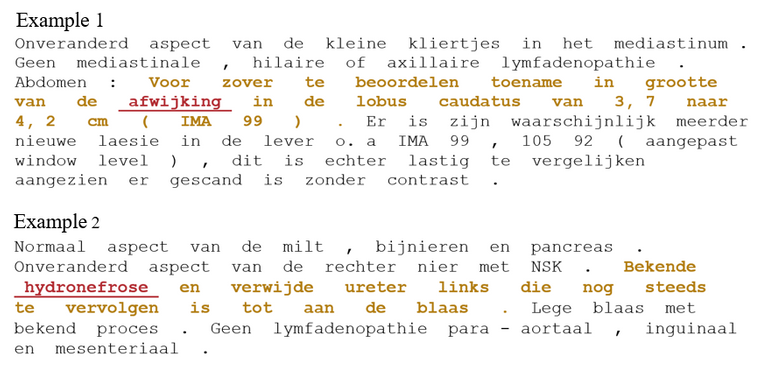Manuela Bergau
Start date: 10-01-2022
End date: 10-07-2022
Thomas van den Broek
Start date: 11-10-2021
End date: 11-04-2022
Clinical Problem
The work of a radiologist is to describe relevant findings that can be seen in an imaging study in the form of a free text report. Although radiologists learn to report their findings in specific ways, following a certain writing style and vocabulary, and sometimes even start from templates that relate to the clinical question and the type of scan acquired, the text is to a large extent unstructured. If we want to use the images and their reports for research, this is a big limitation. It is also an interesting challenge for natural language processing (NLP) researchers.
Converting radiology reports into structured information would have many
possible applications. In this project, we focus on lesions that are visible in
CT scans. Radiology reports list the presence of such lesions, and often
contain numbers from measurements of the size of the lesion and provide the
type of lesion and mention where the lesion is located. For example, the report
may say “Nodus in de linker bovenkwab, 7 mm, binnen marge van meetfout
ongewijzigd vergeleken met vorig onderzoek, is afgenomen vergeleken met
There are two direct use cases for this method related to two ongoing PhD research projects at Radboudumc and Radboud University. The first is to use text-processing to efficiently collect more training and validation data to improve a universal lesion segmentation algorithm that has been developed by Max de Grauw. The second is to prepare parts of an annotated radiology report that is more understandable to a patient, the task addressed in the project of Koen Dercksen.
Data
A database of 250,000 Dutch radiology reports from CT studies where the thorax, abdomen or both were imaged are available. Protected health information has been removed from these reports using in-house developed tools. All studies were done at Radboudumc between 2000 and 2021.
Methods
We propose a solution to this problem in the form of an algorithm that determines which words are possible lesion words and which other words in the report pertain to a particular lesion, known as relation extraction. This is done by employing a multi-task learning algorithm that uses BERTje (BERT for dutch texts) as its shared layers between the described main task and several auxiliary tasks. The auxiliary tasks used are part of speech tagging, lesion detection in the reports, and SNOMED mention detection; SNOMED is a medical vocabulary database. A second objective is to perform coreference resolution to offer a complete overview of the information that is present for each lesion.
Results
We trained the multi-task learning model on 78 different reports which yielded 297 different data points. These reports were selected based on several criteria aimed at maximizing the relevant information per report. The algorithm managed to obtain an F1 score of 0.91 on the relation extraction task. However, the coreference task proved to be too challenging for the current setup and relatively small amount of available labelled data points and only managed to obtain an F1 of 0.51. Regardless, the main purpose of the algorithm, i.e., relation extraction was quite successful.

The examples above serve to illustrate the functioning of the algorithm. The words in red show which word was used as a target for the prediction, the words in yellow are the words that the algorithm predicted belong to said target word.




